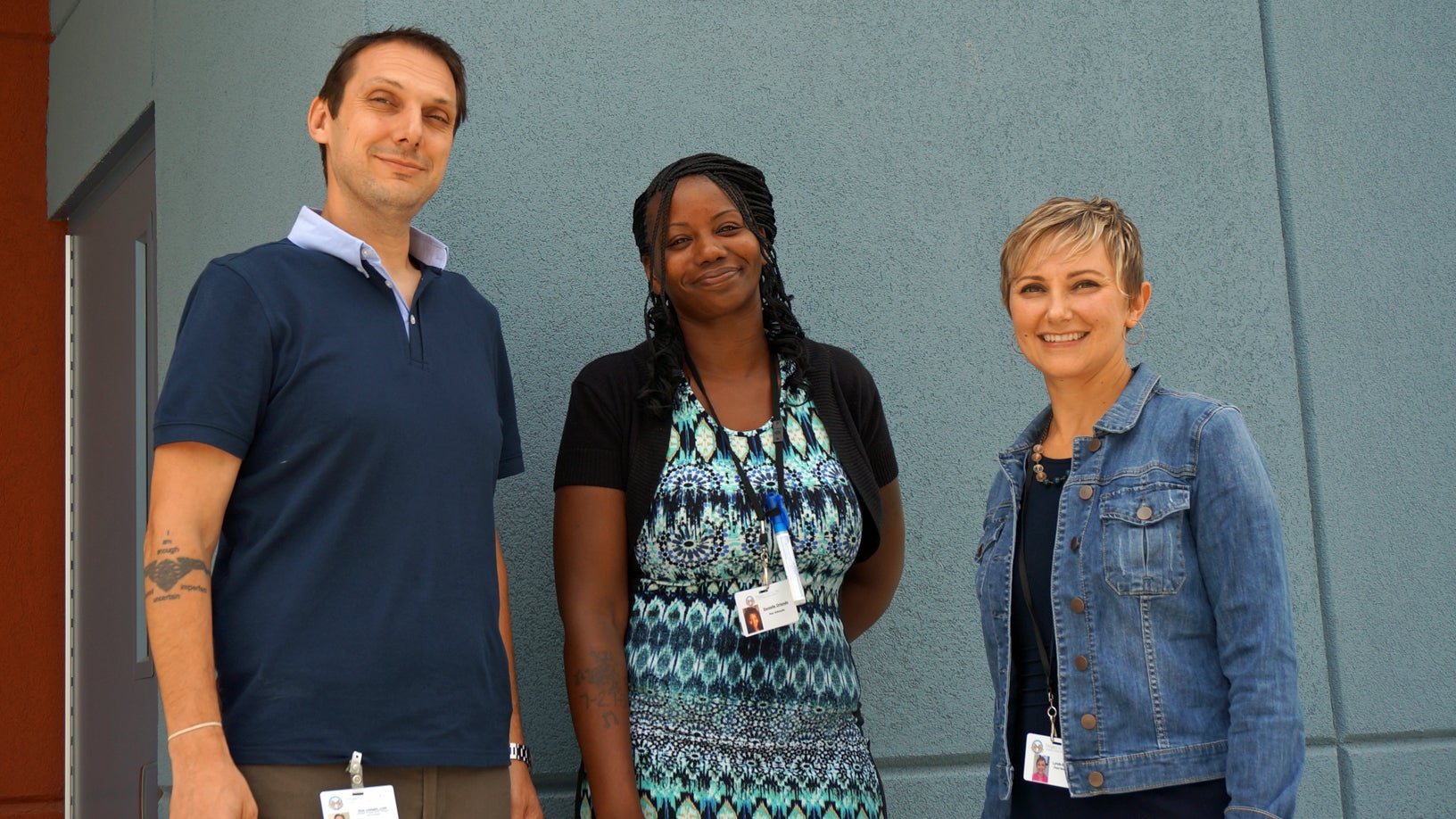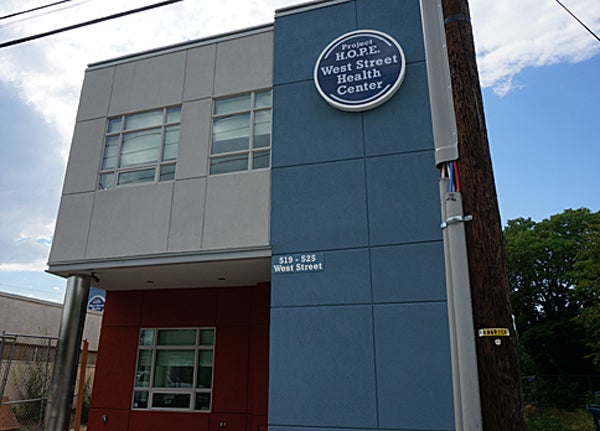Camden clinic deploys ‘miracle drug’ that helps some conquer opioid addiction
Listen
Project Hope, a primary care clinic in Camden, is using buprenorphine to fight opioid addiction. From left to right, social worker Brian Colangelo, peer advocate Danielle Orlando, and physician Lynda Bascelli. (Jessica McDonald/WHYY)
At Project Hope, a primary care clinic located a few blocks west of Broadway in Camden, patients come in for the typical complaints: infections, asthma, diabetes and high blood pressure.
But along with nagging colds, addiction looms large. At least once a day, Dr. Lynda Bascelli sees patients who are drunk or high. For the 25 percent of patients who struggle with substance abuse problems here, providing good basic medical care means treating the addiction first.
“Whether they walked in because they need their blood pressure medicine or their diabetes medication, the addiction is their life-threatening illness,” said Bascelli. “Their opioid dependence, or whatever it is, their alcohol dependence, that’s what’s going to get them before the blood pressure or diabetes will.”
Death from drug overdoses is at an all-time high, propelled by the rise of prescription painkillers and addicts who often then turn to heroin. The epidemic is getting attention as it hits the suburbs and rural areas, but in Camden — one of the nation’s poorest cities — drug abuse has long been an issue. And primary care offices such as Project Hope, which is one of five federally qualified health centers in New Jersey, are one of the few places low-income patients can get help.
Getting cleanOne of the key elements in Project Hope’s integrated approach to medical care is peer advocate Danielle Orlando, who’s in recovery herself. She got hooked on heroin after first taking prescribed pain pills following some dental care.
“A so-called friend said that they had something that was cheaper, and you know, better, and that’s how I got into heroin,” she said. “And it wasn’t cheaper, but it definitely was better, and it just destroyed my life very quickly.”
After Orlando’s first grandchild was born, she was ready to quit. She got an appointment at Project Hope for a Friday, but couldn’t wait. Desperate, she walked in on Wednesday, and they squeezed her in.
“They kind of helped me and gave me a script, and I’ve been clean ever since,” said Orlando.
That was more than a year and a half ago. The script was for buprenorphine, more popularly known as Suboxone.
A ‘miracle’ drugBuprenorphine binds to the same opioid receptors in the brain as heroin or oxycodone, but doesn’t pack the full punch; it works to ease the symptoms of withdrawal.
“It is a miracle drug,” said Orlando. “It kind of just stops the pain, and it’s almost immediate.”
Although people who have never used opioids before can experience a high on buprenorphine, those using the medication to quit heroin just feel normal. If people take a larger dose, there’s a ceiling effect that prevents an accompanying high, and it’s much more difficult to overdose on than either heroin or methadone.
For years, Orlando’s only worry was how many bags of dope she had left. With buprenorphine, she can think again of her children, her job, and her bills.
“I know I can wake up,” she said, “and I can function.”
The transformation, Bascelli said, is often remarkable. People literally look healthier.
“It’s actually stunning to see,” she said. “They come back a few days later, and it’s like a different person. It’s really cool.”
 Project Hope’s new building opened this summer. The federally qualified health center is a primary care clinic that serves low-income patients and the homeless. (Jessica McDonald/WHYY)
Project Hope’s new building opened this summer. The federally qualified health center is a primary care clinic that serves low-income patients and the homeless. (Jessica McDonald/WHYY)
Smaller victoriesFor all of buprenorphine’s potential, the reality is that few patients triumph like Orlando, who’s working at Project Hope as a peer advocate and going to school full time. Most people taking the medication relapse — not just once, but over and over. Some sell the drug on the street, where it’s increasing popular.
Robert DuPont, the first director of the National Institute on Drug Abuse and current president of the Institute for Behavior and Health, is concerned that on a societal level, not enough people are truly recovering from their addictions when assisted with the drug.
“Buprenorphine is kind of the mainstay of the government’s response to the heroin epidemic right now,” he said. “It has a role, but it also has a lot of limitations that I don’t think people are talking very much about.”
At Project Hope, long-term recovery is the goal, but in practice the team has had to accept smaller victories.
“For other folks, we’ve sort of managed to keep them alive,” said Bascelli. “We’ve managed to keep them out of the emergency room, out of the hospital, prevent overdoses. That’s success also.”
To combat diversion, Project Hope carefully selects the patients who join their buprenorphine program and does drug testing. Through a grant from the Nicholson Foundation, the team is one of 12 across the state to participate in a bimonthly video conferencing call to buprenorphine experts to get advice on their toughest cases. And after two years of prescribing the medication, Bascelli was inspired to study addiction medicine, and received board certification in the specialty in November.
Despite precautions, social worker Daniel Colangelo acknowledges that some of the medications the clinic prescribes end up on street corners. But, he said, it’s still worth it.
“To be quite honest, I’d rather see someone on Suboxone than on heroin,” he said. “It’s easier to get heroin than it is to get Suboxone, and we think that should be the other way around.”
On the medication, drug users decrease their risk of contracting HIV and hepatitis C. They’re also less likely to engage in risky or illegal behavior.
“The more Suboxone that folks can have access to,” Colangelo said, “the less heroin they’re going to take.”
A long waitAccess to buprenorphine is restricted, in part by the government. Only doctors who are trained and sign up for a waiver are allowed to prescribe it. In the first year, physicians can treat only 30 patients; in following years, that rises to 100.
According to an online federal database, Project Hope has two of the eight doctors in Camden who are registered to prescribe the drug. But even here, Colangelo said, more than 300 people are on the waiting list.
“We probably get six to 10 phone call requests per day, people looking for Suboxone treatment,” he said. “That’s how much of a demand there is.”
At Project Hope, the real constraint is the number of addiction counselors. Anyone who gets a prescription also has to check in monthly with a therapist, and for patients on Medicaid those experts can be tough to find. Project Hope provides them, but has limited staff, and can help only about 100 patients at any time.
For peer advocate Danielle Orlando, therapy has been just as essential as the buprenorphine.
“Just dealing with some of those demons that I’ve been trying to cover up for so long, it really helps,” she said. “And so the Suboxone is definitely not jut a miracle drug that just fixes everything. You have to do, you know, your work. That’s what I did and that’s what I try to explain to people: You gotta go back to move forward.”
WHYY is your source for fact-based, in-depth journalism and information. As a nonprofit organization, we rely on financial support from readers like you. Please give today.

